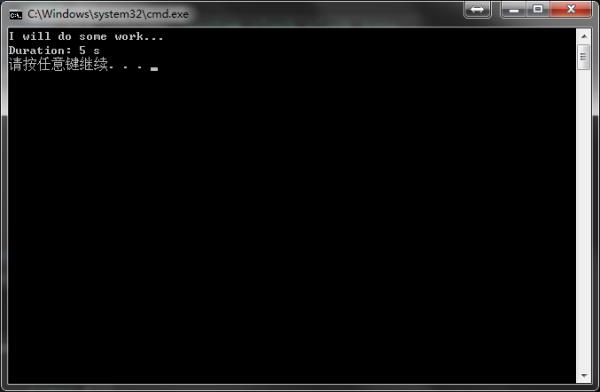如何使用C++11实现跨平台的定时器timer
Posted
tags:
篇首语:本文由小常识网(cha138.com)小编为大家整理,主要介绍了如何使用C++11实现跨平台的定时器timer相关的知识,希望对你有一定的参考价值。
一个Timer的实现需要具备以下几个行为:StartTimer(Interval, ExpiryAction)
注册一个时间间隔为 Interval 后执行 ExpiryAction 的定时器实例,其中,返回 TimerId 以区分在定时器系统中的其他定时器实例。
StopTimer(TimerId)
根据 TimerId 找到注册的定时器实例并执行 Stop 。
PerTickBookkeeping()
在一个 Tick 时间粒度内,定时器系统需要执行的动作,它最主要的行为,就是检查定时器系统中,是否有定时器实例已经到期。
具体的代码实现思路就是:
在
StartTimer的时候,把 当前时间 + Interval
作为key放入一个容器,然后在Loop的每次Tick里,从容器里面选出一个最小的key与当前时间比较,如果key小于当前时间,则这个key代表的
timer就是expired,需要执行它的ExpiryAction(一般为回调)。
这里有两个实现的细节:
获取当前时间
包含时间精度,使用系统时间还是CPU时间(asio里的deadline_timer和steady_timer的区别)
常用的API是:
Windows: QueryPerformanceFrequency() 和 QueryPerformanceCounter()
Linux: clock_gettime()
OSX: gettimeofday()或者mach_absolute_time()
当然在C++11里也可以偷懒使用chrono的high_resolution_clock std::chrono::high_resolution_clock
2.timer容器的选择
容器应该能够在很短的时间内找到MinValue
最小堆的find-min复杂度是O(1),所以蛮受人喜欢的
STL里提供有堆的API,make_heap, push_heap, pop_heap, sort_heap
3. PerTickBookkeeping是放在主循环线程还是另起线程
另起线程需要做好线程间通信,asio和skynet有单独的timer线程
一些代码实现:
这是boost.asio的实现的timer_queue,用的是最小堆
asio/timer_queue.hpp at master · chriskohlhoff/asio · GitHub
这是libuv的timer,采用的是红黑树实现(windows),linux下还是最小堆
libuv/timer.c at v1.x · libuv/libuv · GitHub
这是云风的skynet timer实现,采用链表实现
skynet/skynet_timer.c at master · cloudwu/skynet · GitHub 参考技术A #include <iostream>
#include <chrono>
#include <thread>// include for the test
struct timer
typedef std::chrono::system_clock clock_type;
typedef std::chrono::time_point<clock_type> time_type;
timer() : tic clock_type::now()
~timer()
time_type const toc = clock_type::now();
using namespace std::chrono;
std::clog << "Duration: "
<< duration_cast<std::chrono::seconds>(
toc - tic).count() << " s\\n";
private:
std::chrono::time_point<std::chrono::system_clock> const tic;
;
int main()
timer t;
std::cout << "I will do some work...\\n";
std::this_thread::sleep_for(std::chrono::seconds 5 );// replace this by some time-consuming work
return 0;

C#定时器怎么写?
关于C#中timer类 在C#里关于定时器类就有3个1.定义在System.Windows.Forms里
2.定义在System.Threading.Timer类里
3.定义在System.Timers.Timer类里
System.Windows.Forms.Timer是应用于WinForm中的,他是通过Windows消息机制实现的,类似于VB或Delphi中的Timer控件,内部使用API SetTimer实现的。他的主要缺点是计时不精确,而且必须有消息循环,Console Application(控制台应用程式)无法使用。
System.Timers.Timer和System.Threading.Timer很类似,他们是通过.NET Thread Pool实现的,轻量,计时精确,对应用程式、消息没有特别的需要。System.Timers.Timer还能够应用于WinForm,完全取代上面的Timer控件。他们的缺点是不支持直接的拖放,需要手工编码。
using System;
using System.Collections.Generic;
using System.ComponentModel;
using System.Data;
using System.Drawing;
using System.Text;
using System.Windows.Forms;
using System.Timers;
using System.Collections;
namespace WindowsApplication1
public partial class Form1 : Form
public Form1()
InitializeComponent();
private void Form1_Load(object sender, EventArgs e)
System.Timers.Timer aTimer = new System.Timers.Timer();
aTimer.Elapsed += new ElapsedEventHandler(theout); //到达时间的时候执行事件;
// 设置引发时间的时间间隔 此处设置为1秒(1000毫秒)
aTimer.Interval = 100000;
aTimer.AutoReset = true;//设置是执行一次(false)还是一直执行(true);
aTimer.Enabled = true; //是否执行System.Timers.Timer.Elapsed事件;
public void theout(object source, System.Timers.ElapsedEventArgs e)
ArrayList AutoTask = new ArrayList();
AutoTask.Add("8:30:00");
AutoTask.Add("9:30:00");
AutoTask.Add("10:30:00");
AutoTask.Add("11:34:15");
for (int n = 0; n < 4; n++)
if (DateTime.Now.ToLongTimeString().Equals(AutoTask[n]))
MessageBox.Show("现在时间是" + AutoTask[n]);
2.
C#.net 定时器
最近需要用到一个定时器,设定当 程序 到某时刻 执行某段代码。
using System;
using System.Timers;
namespace 定时器ConsoleApplication1
class Class1
[STAThread]
static void Main(string[] args)
System.Timers.Timer aTimer = new System.Timers.Timer();
aTimer.Elapsed += new ElapsedEventHandler(TimeEvent);
// 设置引发时间的时间间隔 此处设置为1秒(1000毫秒)
aTimer.Interval = 1000;
aTimer.Enabled = true;
Console.WriteLine("按回车键结束程序";
Console.WriteLine(" 等待程序的执行......";
Console.ReadLine();
// 当时间发生的时候需要进行的逻辑处理等
// 在这里仅仅是一种方式,可以实现这样的方式很多.
private static void TimeEvent(object source, ElapsedEventArgs e)
// 得到 hour minute second 如果等于某个值就开始执行某个程序。
int intHour = DateTime.Now..Hour;
int intMinute = DateTime.Now.Minute;
int intSecond = DateTime.Now.Second;
// 定制时间; 比如 在10:30 :00 的时候执行某个函数
int iHour = 10;
int iMinute = 30;
int iSecond = 00;
// 设置 每秒钟的开始执行一次
if( intSecond == iSecond )
Console.WriteLine("每秒钟的开始执行一次!";
// 设置 每个小时的30分钟开始执行
if( intMinute == iMinute && intSecond == iSecond )
Console.WriteLine("每个小时的30分钟开始执行一次!";
// 设置 每天的10:30:00开始执行程序
if( intHour == iHour && intMinute == iMinute && intSecond == iSecond )
Console.WriteLine("在每天10点30分开始执行!";
参考技术A 1楼的回答的非常详细了,
1.定义在System.Windows.Forms里
2.定义在System.Threading.Timer类里
3.定义在System.Timers.Timer类里
平时多查查MSDN,上面有帮助说明和示例。 参考技术B setTimeout(SetInitialize, 1000);
SetInitialize是方法名
java脚本的
以上是关于如何使用C++11实现跨平台的定时器timer的主要内容,如果未能解决你的问题,请参考以下文章